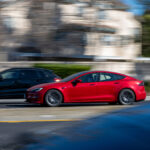Consumer Reports said Thursday that Tesla Motors is misleading car owners by calling its semi-autonomous driving system “Autopilot,” potentially giving them too much trust in their car’s ability to drive itself.
The influential magazine said Tesla should drop the Autopilot name and disconnect the automatic steering system until it’s updated to make sure a driver’s hands stay on the wheel at all times. The system currently warns drivers after a few minutes of their hands being off the wheel.
In an e-mail, a Tesla spokeswoman said the company has no plans to change the name, and that data it collects show drivers who use Autopilot are safer than those who don’t.
With its statement, Consumer Reports joined a debate over autonomous driving technology that escalated after authorities revealed that Joshua Brown, 40, of Canton, Ohio, died in a May crash in Florida with the Autopilot on in his 2015 Model S. The system didn’t detect a tractor-trailer that had turned in front of the car in bright sunshine, and Brown also failed to react.
The National Highway Traffic Safety Administration is investigating the wreck and the functioning of the Autopilot system. After the Brown crash, critics accused Tesla of giving drivers access to a system that wasn’t ready, while supporters contended the company was improving automotive safety.
Tesla’s Autopilot system uses cameras, radar and computers to detect objects and automatically brake if the car is about to hit something. It also can steer the car to keep it centered in its lane. The company says that before Autopilot can be used, drivers must acknowledge that it’s an “assist feature” that requires both hands on the wheel at all times. Drivers also must be prepared to take over at any time, Tesla has said.
Yet Laura MacCleery, Consumer Reports’ vice president of consumer policy, said naming the system Autopilot gives drivers a false sense of security. Autopilot, she wrote, can’t actually drive the car, but it lets consumers keep their hands off the steering wheel for minutes at a time.
“We’re deeply concerned that consumers are being sold a pile of promises about unproven technology,” she said in a statement.
Earlier this week Tesla disclosed that a Model X SUV crashed early Saturday in Montana while the driver was using the autosteer feature on a two-lane road, which is not recommended by the company. Tesla, which gets information from its cars over the internet, said the car warned the driver at least once to place his hands on the steering wheel before it crashed.
MacCleery called on the Palo Alto, California, company to disable automatic steering until it updates the computer program to ensure a driver’s hands are on the wheel.
Consumer Reports also said Tesla should issue clearer guidance on how Autopilot is used and what its limitations are. Tesla CEO Elon Musk has said he’ll provide more thorough guidance in a blog posting, and the spokeswoman said that was coming.
Tesla released Autopilot last fall and says the system is still in a “public beta,” or testing phase. Critics have complained that Tesla is using drivers as “guinea pigs” – a sentiment echoed by Consumer Reports.
Tesla said Autopilot underwent millions of miles of internal testing and is updated constantly. “We will continue to develop, validate, and release those enhancements as the technology grows,” the spokeswoman said.
Not all magazines that test cars are critical of Tesla and Autopilot. Road and Track said on its website this week that Autopilot is a technological achievement that should make America proud. Autopilot is at least as safe as human drivers on the highway, in a car that doesn’t use gasoline and performs like a sports car, the magazine said.
Consumer Reports has expressed concerns about Autopilot before. During a November podcast, Jake Fisher, auto testing editor, said the system provided an added layer of confidence. But he was surprised that he could take his hands off the wheel for 2 1/2 minutes at a time and browse the web on its dashboard screen while driving.
In February, Consumer Reports urged Tesla to change a feature within Autopilot known as Summon, which lets owners start cars and move them out of a garage or parking spot automatically using a key fob or a smartphone. The magazine found that users couldn’t stop the cars right away if they pressed the wrong button on the key fob. It also found that the cars kept moving when the smartphone app was closed. Tesla responded with a software update that limited the Summon feature to smartphones and required the user to keep a finger on the phone screen when the car was being summoned.
Was this article valuable?
Here are more articles you may enjoy.

 Tesla a Step Closer to Ride-Hailing With California Permit
Tesla a Step Closer to Ride-Hailing With California Permit  BYD’s Five-Minute Charges Turning Heads in EV Industry
BYD’s Five-Minute Charges Turning Heads in EV Industry  California Insurance Commissioner Provisionally OK’s State Farm’s 22% Rate Request
California Insurance Commissioner Provisionally OK’s State Farm’s 22% Rate Request  Bayer Weighs Billions in Capital Raise for Lawsuits, Shares Tumble
Bayer Weighs Billions in Capital Raise for Lawsuits, Shares Tumble 